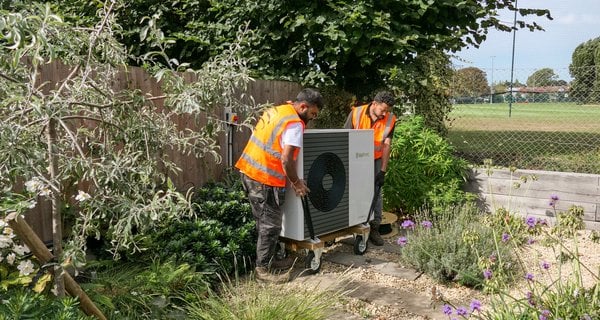What did we do?
We conducted 10 in-depth, one-on-one interviews with individuals living across the UK. Participants were selected to reflect a mix of housing types, tenures, heating systems and local contexts. This diversity allows us to explore how different household characteristics might shape people’s reactions to a clean heat neighbourhood approach.
We took a participatory approach grounded in activity-based research. In this phase, we invited participants to shape what a clean heat neighbourhood could feel like from their perspective – how it’s introduced, who makes which decisions, and what kind of information would help them feel confident taking part.
The interviews were structured around a set of hands-on exercises designed to prompt personal interpretation, reflection, and decision-making. This design-led approach helped us surface participants’ expectations, concerns, and mental models around a neighbourhood-wide shift to clean heat. It also gave us insights into the kinds of information, support and timing they need to feel confident moving forward.
Each 45-minute session explored three core areas of interest. Participants:
- reacted to staged communications simulating how a clean heat neighbourhood might be introduced over time
- reflected on which aspects of the process they felt should be individual vs coordinated
- designed their own journey, mapping the support, information and actions they would want between being notified and actually switching to clean heat.
We used a Miro board to make these workshop sessions feel interactive and tangible in an online setting. This allowed participants to engage visually with the materials in real time as we moved through the exercises together.
Overview of the three activities
The first activity
Touchpoint 1: simulating a national campaign ad
We began by presenting a three-part sequence of communications that simulate how households might first come into contact with a clean heat neighbourhood in the real world. Each message represented a different touchpoint and level of proximity, moving from broad (national) to personal (household).
In our previous testing, we introduced clean heat neighbourhoods using a single letter and text message. People said it lacked context, and felt “nervous or singled out as no rationale was given”. In this phase, we tested whether a sequenced and layered communication approach across three scales (national → local → household) could build confidence in the legitimacy, coordination and relevance of clean heat neighbourhoods for households over time.
The second activity

An example of clean heat neighbourhood elements placed on an individual vs coordinated diagram by a participant
After exploring participants’ expectations for how a local clean heat neighbourhood scheme might be rolled out and introduced, we presented a set of digital cards representing possible key elements in a clean heat neighbourhood process (eg, ‘Opt-in timing’, ‘Installer selection’, ‘Street improvements’).
Participants were asked to place each card along a simple diagram divided between ‘individual’ and ‘coordinated’, depending on whether they saw the element as a personal decision, or one shared or led by others. This sparked conversations about where people wanted more control and where they were open to coordination. This activity was shaped by insights from Phase 1, where we heard that while social reinforcement may build confidence in the scheme, people still valued having their own say.
There was a clear desire for a balance between the convenience of coordination and the preservation of individual agency. Here, we explored how those preferences play out in specific elements of a clean heat neighbourhood scheme.
The third activity

An example of a clean heat neighbourhood journey created by a participant
Our previous testing highlighted a common barrier to clean heat neighbourhood adoption: the technologies being proposed often feel unfamiliar. Compared to more traditional heating systems, such as boilers, low-carbon systems can seem abstract, harder to visualise, or less intuitive. We saw the importance of building trust in the technology itself – people want to understand what it is, how it works, and why it fits in their home.
To explore this, we facilitated a ‘mapping the journey to confidence’ activity. Participants were given a defined start point (clean heat neighbourhood is identified) and an end-point (your home switches to clean heat). We asked them: If you could design a scheme/process for your area, what would it look like? What would help you feel confident between these two moments? When would you want that information or support? Participants were provided with some prompts (indicated in blue), and we encouraged them to add their own (indicated in yellow).








